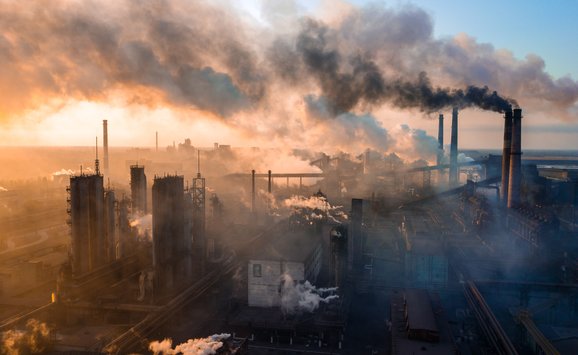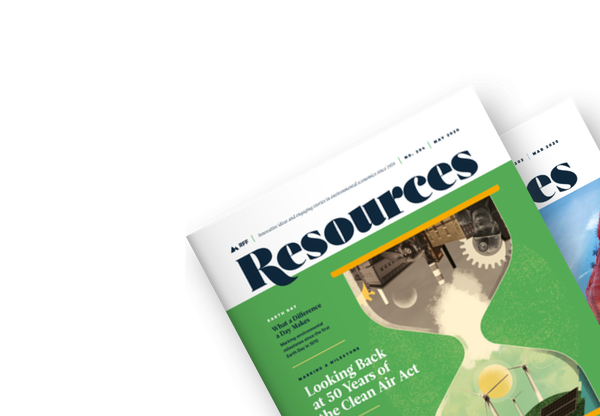Twice a month, we’re compiling the most relevant news stories from diverse sources online, connecting the latest environmental and energy economics research to global current events, real-time public discourse, and policy decisions. Keep reading, and feel free to send us your feedback.
Here are some questions we’re asking and addressing with our research chops this week:
How robust is the science behind higher estimates of the social cost of carbon?
An executive order signed by President Donald Trump directs the US Environmental Protection Agency to consider updating or eliminating the social cost of carbon (SCC), an estimate of the cost to society of emitting an additional ton of carbon dioxide emissions. The Biden administration increased the SCC based on recent advances in economics and science, drawing on research by scholars at Resources for the Future (RFF). In a new blog post, RFF Fellows Brian C. Prest and Kevin Rennert refute a recent third-party analysis of the SCC that critiques the higher estimate for reasons similar to those referenced by the Trump administration. Yet, ultimately, this third-party analysis “confirms that the upward revision to the SCC is appropriate and robust, even against changes outside the current state of the science,” say Prest and Rennert.
What reform options are available in electricity markets that allow firms to buy power from electricity generators and sell that power to households?
A new law in Maryland aims to protect consumers from unreasonably high electricity bills. Firms in Maryland are allowed to purchase power from electricity generators and sell that electricity to households in what’s known as a retail choice market. However, consumer complaints about manipulative marketing practices, which lead to ballooning electricity bills and occur disproportionately in low-income communities, have plagued the retail choice market in Maryland. The new law puts limits on marketing by electricity retailers and the kinds of contracts that firms can offer households. Advocates say the law will save households in Maryland $150 million per year, while retailers warn the law could harm competition. Before it passed, testimony on the bill referenced research by RFF Fellow Jenya Kahn-Lang, who discussed that work on a recent episode of the Resources Radio podcast. “These markets could provide a great learning experience about how to best protect consumers and promote efficient competition,” says Kahn-Lang.
What are the climate benefits of reducing methane emissions compared to reducing carbon dioxide emissions?
New legislation proposed in Congress would repeal a fee on emissions of methane that was finalized in November and is required by the Inflation Reduction Act, the major climate law that passed in 2022. The fee incentivizes limits on methane leaks at oil and gas production sites. Reducing these leaks would help US firms comply with EU standards on imports of liquefied natural gas and help curb climate change. “Reducing methane emissions will … reduce the global temperature,” say RFF University Fellow Thomas Sterner and coauthors in a recent Resources magazine article about balancing climate policy that targets methane emissions versus carbon dioxide emissions. “To meet the targets of the Paris Agreement, climate policies need to regulate both carbon dioxide and methane emissions,” say Sterner and coauthors. “A key question is how much to value the mitigation of carbon dioxide emissions vs reductions in methane emissions.”

Expert Perspectives
Fledgling US Clean Hydrogen Industry Faces Uncertain Future
The US Department of Energy canceled meetings with representatives from several hydrogen hubs last week, amid an ongoing review of all the agency’s programs. Separately, over 100 interested parties submitted a letter to key Republican members of Congress to maintain the 45V tax credit that incentivizes the production of clean hydrogen.
“The process of producing hydrogen can generate a lot of carbon dioxide. But methods of producing clean hydrogen that involve zero- or low-carbon electricity generation do exist,” says RFF Senior Fellow Alan Krupnick. “‘Green hydrogen,’ which is produced through a process known as electrolysis, can be powered by renewable energy. And carbon dioxide emissions can be captured when fossil fuels are the inputs for making so-called ‘blue hydrogen.’
“The Bipartisan Infrastructure Law, passed in 2021, allocates $7 billion for the development of hydrogen hubs, which are supposed to become networks of clean hydrogen producers and consumers in regions across the United States. The potential benefits from the hydrogen hubs program are large,” says Krupnick. “Clean hydrogen is a potential alternative to fossil fuels in industrial sectors that are difficult to decarbonize, such as steel and shipping. The hydrogen hubs are meant to help jump-start a domestic clean hydrogen industry.
“But funding for federal programs that are associated with decarbonization may be vulnerable, even if the laws on the books require that this funding be disbursed. This concern applies to funding for the seven hydrogen hubs that the federal government already has selected to support. The hydrogen hubs program is in phase one of four phases; only preliminary funding has been disbursed for planning purposes. On the other hand, hydrogen fuel has had bipartisan support for a long time, and 45V, as evidenced by the letter to Congress, has powerful supporters, including the American Petroleum Institute, the US Chamber of Commerce, and a long list of companies in the hydrogen ecosystem.”

Resources Roundup

What’s the Cost of Making Forests in California More Resilient to Wildfire?
In California, wildfires are becoming increasingly frequent and destructive, with damages producing exorbitant costs. But forests can be made more resilient so that, when fires do start burning, the conflagration is not as damaging. In this working paper, RFF researchers analyze two forest-treatment strategies: prescribed burning (deliberately burning areas to remove excess vegetation that can fuel fires) and mechanical thinning (using machinery to remove vegetation and reduce the density of forested areas). They examine the relative cost of these treatments, exploring site-specific cost estimates. “Our findings suggest that current levels of state and federal funding may be sufficient to achieve the lowest-cost treatment goals,” conclude the authors, “but more ambitious strategies would require substantial increases in funding.”
Insurers Can Take On the Risk of Developing New Clean Energy Technologies
Making progress on the clean energy transition requires investment in the development of new technologies. But many innovative companies struggle to obtain financing to get new technologies from the prototype stage to deployment—emerging technologies come with uncertainty about whether they will perform at scale, a perceived risk that often deters investors. One potential solution may lie in insurance markets. In this new report, RFF scholars Yuqi Zhu and Aaron Bergman explain how insurers can help absorb the risks associated with scaling up new technologies by assessing the viability of the technology, pricing it, and providing coverage if it fails. Zhu and Bergman also examine policy options for governments to expand these markets and facilitate cooperation between technology developers and insurers.
Balancing Regulatory Flexibility with Stronger Wildfire-Mitigation Efforts
Smoke from wildfires is detrimental to air quality, filling the air with pollutants such as carbon dioxide, carbon monoxide, and harmful particulate matter. The US Environmental Protection Agency monitors air quality to ensure that states meet Clean Air Act standards. However, the agency’s Exceptional Events Rule allows air-quality readings that are affected by wildfire smoke to be excluded from assessments of compliance with air-quality standards. In a recent journal article, RFF researchers examine this rule and consider how revisions to the rule could support efforts to reduce wildfire risk, along with possible legal and policy solutions.

🎨 Climate in the Culture 🎵

What makes a movie a “climate movie”? The genre has expanded in recent years; best known, perhaps, is the on-the-nose parable Don’t Look Up, in which a comet (read: climate change) approaches Earth on a collision course while humans shrug. Flow, a silent animated film about a cat surviving a mysterious flood, offers a subtler vision for the genre. When the flood arrives, the cat bands together with a few other animals to find higher ground as the world submerges. Gints Zilbalodis, the film’s director, told Heatmap that he did not intend to make a point about environmental catastrophe: “I can’t really start with the message; I have to start with the character.” His priorities show. Flow’s hero convinces as a cat and a character, complete with fear and growth, and earns the affection of the audience. So, is Flow a climate movie? The environmental themes don’t need emphasis, yet aren’t understated at all. With floods intensifying across the world, audiences bring the context with them. Flow doesn’t tell the audiences what’s wrong, but offers catharsis instead. Critics seem to like the approach: Flow is up for two Oscars this year.








